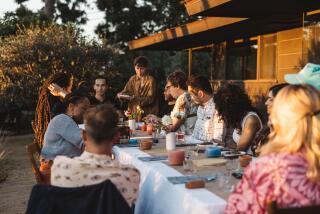Stepping elegantly into the past at the Ebell of Los Angeles
Each Monday in a building on Wilshire Boulevard, women gather for a luncheon prepared by an in-house chef. At round tables in a large and lofty dining room, they greet old friends, make new ones, converse, maybe even debate. Over dessert, they are entertained by a speaker — a painter, perhaps, or a novelist or a historian of early Los Angeles.
Often they come to do good works, doling out college scholarships and money to help women in need. Sometimes they show up for a happy hour or for classes — on cooking or writing a memoir.
And of an evening, now and then, in their silk and sequined gowns, they arrive at the building accompanied by tuxedoed men in cummerbunds. There is a band. They dine. They dance. They step into the courtyard and gaze upon its elegant fountain.
The fountain is the work of Henry Lion, who designed the front doors of City Hall. At its center is a graceful bronze maiden who honors “husbands, brothers and sons” lost in the First World War. She is meant to inspire hope, and above her head, she holds the lamp of learning in an open palm.
It was a desire for learning and finding ways to be of service that long ago drove a small group of women to form the Ebell of Los Angeles, a club that on Sunday will hold its very first open house.
In 1894, when the Ebell was founded, college was rare for women, and their opportunities for formal study were limited. So Ebell members lined up erudite speakers and prepared edifying presentations on Robert Browning, Shakespeare, Cleopatra and ancient Egypt, Berlin art, prison reform, Queen Dido and Jezebel.
Times and tastes have changed a bit. But the Ebell of Los Angeles lives on. It has somehow managed to cleave true to its core missions while evolving in ways its founders would find flummoxing.
Once all-white, the club is now diverse. Its president is African American, it counts four (non-voting) men in its ranks, and its members, ages 19 to 101, come from all sorts of neighborhoods and backgrounds. Many work for a living. Most are college graduates.
Sadly, though, despite a not-at-all-snooty admissions process and modest annual dues of $220, modern times make for fewer members than there used to be.
The club would like to have more than the 360 it has. It would like to see a lot of youthful applicants.
When it flings open its doors Sunday, members hope newcomers will fall for the place.
From 1 p.m. to 4 p.m., at 743 S. Lucerne Blvd., there will be cookies and coffee and clubhouse tours and a pipe organ playing in the club’s Wilshire Ebell Theatre.
More than that, there will be an opportunity to view something uncommon here: a piece of history so cherished and lovingly protected that it remains in many ways frozen in an earlier era.
The original furniture is all there — in the art salon, in the practically football-field-size “lounge.” The walls are lined with plein-air paintings popular when the building was new. Club records — including early yearbooks with studio portraits of each member — have been carefully passed down generation to generation and are now being meticulously archived.
“It is an absolutely fascinating place, hidden in time,” says Shirlee Taylor Haizlip, the author of three nonfiction books and the club’s president, who says she feels “like a proud parent, thrilled about the chance to show my baby off.”
The club was named after Adrian Ebell, who was born in Ceylon, raised in New York and in his brief life of 37 years ran a magic-lantern show and photographed the Dakota tribe before earning a degree at Yale and studying insects.
Ebell won over women by lecturing about an academy he planned to form, in which they could learn as they made their way on a grand tour of Europe. While visiting Oakland, he helped establish a women’s club there, the first of numerous independently operated clubs founded in his name.
In its early days, the Los Angeles version rapidly outgrew each successive clubhouse, from the Victorian home on Olive Street where its first meetings were held to the grand edifice at 7th and Figueroa streets that immediately preceded the Wilshire building.
By the time the women raised the money for the current clubhouse, there were 3,000 members, which justified the plan for more than 100 rooms spread out across 77,000 square feet. At the time, the 1,270-seat theater — whose rental fees, along with those for weddings and other events, are now a key source of revenue — couldn’t accommodate everyone for regular club meetings; they held morning and afternoon sessions.
At the open house, people can visit the dining room where Amelia Earhart in April 1937 described a recent crash in Hawaii. It was one of her last public speeches, just three months before she disappeared.
They can see the French Room, where a queen of Romania supposedly visited and broke club rules by smoking. And they can soak up the finery in rooms full of the gorgeous vintage clothes of ladies past — available for member borrowing when the occasion suits.
They can also hear those in the club tell why they love the Ebell.
Haizlip, of Connecticut, who joined in the 1990s when she was new to the city, says the club has given her “at least 50 BFFs.”
Caroline Moser, 53, an architect, says she loves volunteering to preserve the building’s history and getting to know women at many stages of life.
Alex Leroux, a 36-year-old contemporary art dealer, “fell crazy in love with Shirlee and the whole building” and says she appreciates the chance the club gives her to get involved in community service.
No such selfless claims from Jeannine Gregory, who prefers not to state her age but admits to being one of the club’s older members. The Ebell, she says, is “a bed of gracious living.”
“And it’s nice, for heaven’s sake, to go once in a while to a place where you can wear black tie.”
More to Read
Sign up for Essential California
The most important California stories and recommendations in your inbox every morning.
You may occasionally receive promotional content from the Los Angeles Times.











